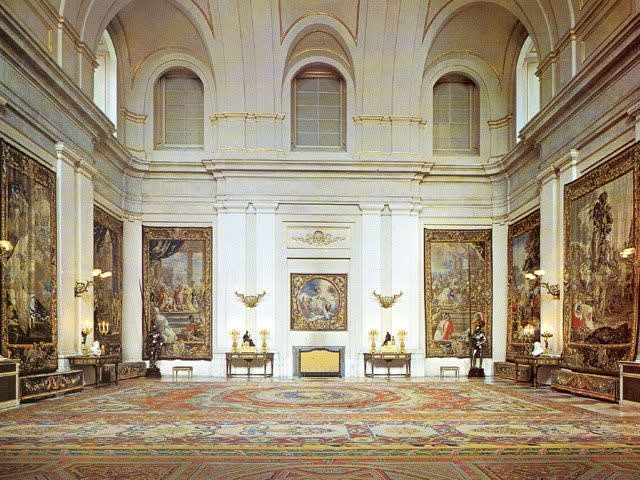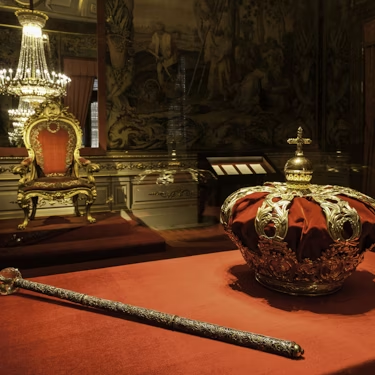More about: Things You Can´t Miss at the Madrid Royal Palace
Of all the activities you can do during your trip to Madrid, there is one that I cannot fail to recommend: a tour of the interior of the Royal Palace. Why? Because within its many walls, halls and rooms there are great stories to discover.
Without a doubt, the royal halls are the rooms that attract the most attention, as they are decorated in great detail. However, in addition to the taste for ornamentation, you will see that many areas of the palace are almost perfectly preserved, so you will be able to get a pretty good idea of where the Spanish monarchs lived for years.
1. The Halberdiers' Hall: the first stop

The first place you are likely to see during your visit to the Royal Palace of Madrid will be the Halberdiers' Hall. It is quite spacious as Sacchetti, the architect behind its creation, intended it as a ballroom. However, Charles III decided that this is where the royal guard (the halberdiers) would be placed. Since then, that is its use whenever there is an official visit.
When you enter you will see that its interior is solemn and that, with the exception of the ceiling which has a mythological painting of Aeneas and Venus, there is not much decoration. Why? Precisely because of this change in its use. Instead of the original rich ornamentation, they opted for pilasters and a much simpler design.
Nevertheless, the taste for art has ended up in the Salón de Alabarderos, mainly because of the large painting of the family of Juan Carlos I that presides over the room. In addition, there are other canvases and mahogany furniture that add to the warmth of the place.
2. The Throne Room: a historic place

The Throne Room is a space not to be missed, it's all about history! This is where, since its decoration was completed in 1772 during the reign of Charles III, visitors have been received in an official and ceremonious manner.
It was also the place where, when they died, the kings' burial chapels were placed until they were taken to the royal cemetery, which you can visit if you book an excursion to El Escorial. It could be said to be the central room of the Palace, and in fact it occupies the main façade.
Apart from its historical value due to the personalities who have entered it since the 18th century, the Throne Room, also known as the Ambassadors' Room, is amazing for its vault. It is frescoed with Tiepolo's "The Greatness and Power of the Spanish Monarchy". The history of the royal family is told through allegories, leading the viewer's eye to the throne.
The furniture, especially the throne, is also striking for its artistic richness brought from Italy by Giovanni Battista Natali, who was in charge of designing the space. Before leaving, I advise you to observe the detail and beauty of the golden lions and the sculptures of Minerva and Apollo that watch over the throne.
3. The Hall of Columns: the setting for balls and receptions

Another of the rooms with the most stories to tell is the Hall of Columns. This is where official balls and receptions have been held for centuries, as well as the signing of important treaties, such as Spain's accession to the European Community.
Although knowing everything that has happened within the four walls that enclose this great hall is reason enough to visit it, the classical art you will find there will leave you even more open-mouthed, you'll see!
The first thing your eyes will notice is the sculpture of Charles V of Germany and I of Spain. Be careful, it is a copy of the original, which you will only be able to see if you visit the Prado Museum. What is not a copy are the Belgian tapestries that complete the decoration of the room, although the vault is even more impressive.
The ceiling of the room is painted with a scene in which the sun, a metaphor for the monarch, seems to illuminate the entire space, although it seems impossible to do so with just paintbrushes.
4. The Gasparini Salon: the pinnacle of Rococo art

I know, as soon as you enter the Gasparini Salon you will feel overwhelmed by the decoration. It's normal, the style in which this space was designed is rococo, famous for its ornate style. Despite this (or perhaps because of it), this room is one of the most beautiful in Madrid's Royal Palace. It was not always a salon, as during the time of Charles III it was his chamber.
Although its name has changed and it now bears the surname of the artist who designed it (Matías Gasparini), its interior has not changed in the slightest. When you enter it, you will see it just as the different monarchs throughout history saw it. Like you, I'm sure they too were impressed by the marble floors and the silver thread of the tapestries.
What use is it now put to? After officially receiving visitors in the Hall of Columns, the King and his guests enter this room for an aperitif or a coffee.
5. The Hall of Mirrors: a place for reflecting art

When you enter the Hall of Mirrors, you will, of course, see your image multiplied in the different reflections. When you look away, the next thing you notice is the art that runs along the walls of this space, along with the mirrors. Tomás de Castro was the creator of a meticulous iconographic work, because yes, every sculpture, painting or even wood carving has a meaning.
As you can imagine, the fact that there are so many mirrors has an explanation: this room was the place where kings and queens dressed. In its beginnings it was the consort Maria Luisa of Parma who used this cabinet. In fact, it was designed for her in a very French style, trying to emulate the Palace of Versailles.
As time went by, the Salón de los Espejos has had other uses, and has even been used as a cinema. Alfonso XIII used to meet there with his family to watch films. Nowadays it is where the Royal Orchestra is placed when it has to provide music and rhythm to the great banquets held in the Palace.
6. The Main Staircase: a place that even Napoleon admired.

Although it is not a hall, the Main Staircase of the Royal Palace in Madrid deserves all the attention. The reason? Its Imperial style and its double level. When you go up its 72 marble steps, you will realise what it intends to convey: power and luxury. This is achieved with its balustrade and the large sculpture of Charles III just as you reach the central landing.
The staircase has been modified several times over the years, although don't worry because you won't notice it thanks to the good architectural work of Sabatini, who was in charge of changing the height and layout of the stairs as requested by the king.
I have no doubt that when you see it you will feel the same awe and admiration as Napoleon. The emperor, on climbing the stairs of the Royal Palace after conquering Spain, told his brother Joseph, to whom he left the kingdom, that his house was going to be better than his own in France.
7. The Royal Armoury: a museum of war

More than just a room, the Royal Armoury is a museum in itself. It is located at one end of the Plaza de Armas and houses a large collection of armour and other war objects from the Royal Palace. Just by telling you that it is one of the most recognised and important in the world, you will understand why you should visit it.
If we have anyone to thank for being able to see such a collection, it is Charles III, who stopped giving his armour to religious centres, as was the tradition during the Middle Ages. Instead, he began to keep them and it was his son, Philip II, who brought them all to Madrid. There are hundreds of weapons here, not only Spanish, but also Portuguese and Moorish.
If you get tired of so many war objects, I recommend you go back to the Plaza de Armas and head to the other end, where you will find the Real Botica (Royal Pharmacy). Here, instead of weapons, the museum is made up of flasks, cupboards, ceramic elements... where for years the herbs and natural medicines that were used to cure the royalty were kept.
8. The Royal Chapel: a place of worship

The Spanish monarchy has always been closely linked to the Church, so you should not be surprised to find a church inside the Royal Palace. However, you will feel that something is missing, and you would be right, as the architectural project for the Royal Chapel has never been completed.
As a result, the altar area is rather austere, although the positive thing is that the dome of the ceiling was finished and now looks incredible thanks to the paintings by Sachetti and Ventura Rodríguez.
Protocol was very important in the Chapel and was fully respected, so you will see that there are different areas. The entire court had an assigned place, while the people could only enter at times and only stand in the entrance area, known as the antechapel. On your visit, however, you will be able to get close to the Cancel, the tribune from which the kings heard mass.
You will also be able to see the organ, which is unique for the quality of its sound and for having been made according to tradition. This was the work of Ferdinand VI, for whom music was of paramount importance, especially in sacred territory.
9. The Stradivarius Hall: the jewels of the Crown

The Spanish monarchy may not have a collection of jewels like the British, but I can assure you that the cultural wealth in the Stradivarius Hall is even better. I don't think you've ever seen so many instruments of such high quality together; in total, four pieces (a viola, a cello and two violins) made by the famous Antonio Stradivari in 1700.
These four instruments are part of the Stradivarius Palatinos collection, one of the most important in the world. Don't think that they are only on display for viewing, as they are still used in the concerts held inside the Royal Palace.
10. Gala Dining Room

To get to the Gala Dining Room you first have to pass through the Yellow Sallet, so named because the fabrics that decorate it are of that colour.
Once through the door into the Dining Room it will be obvious that you are entering one of the largest rooms in the Royal Palace. However, it was not originally so large; the current space is the result of the remodelling ordered by Alfonso XII, which saw three rooms joined into one.
What has not changed is its function, as it is still the place where banquets and balls are held when there are official visits or state dinners. During the visit you will be able to see how the table is dressed on these occasions, of course, with the best china.
How many people do you think can eat there at a time? I'm telling you: one hundred and forty-four people. Of course, the table was designed in a very practical way so that it can be picked up quickly and easily, leaving room for dancing after any banquet.
I have no doubt that you are going to enjoy the interior of the Royal Palace of Madrid, walking through its halls and discovering the art in them. Have you made a note of the essential things to do?



